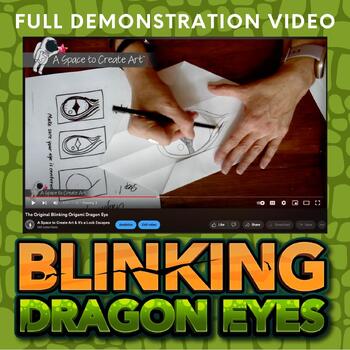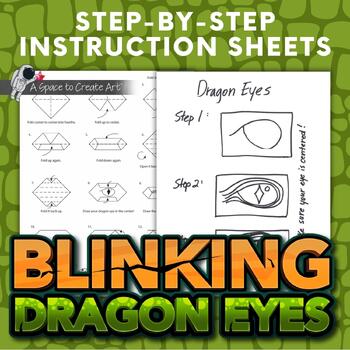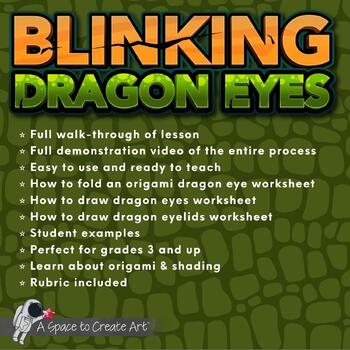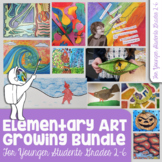Blinking Origami Dragon Eyes - Origami Elementary Art Lesson - Middle School Art
- Zip
What educators are saying
Also included in
- This bundle of Elementary Art lessons includes the Elements and Principles of design poster set for your room as well as full lessons and activities for your classroom. Easy to teach and learn many of these lessons also tie-in with other subjects including Math, ELA and Science. Most suitable for grPrice $100.00Original Price $176.00Save $76.00
Description
This origami dragon eye project gives step-by-step instructions on how to draw, fold and shade a dynamic blinking dragon eye! Students will love drawing and folding these dragon eyes that actually blink when complete! So much fun! With a full presentation, demonstration video of the entire process, and step-by-step worksheets on how to draw and how to fold this lesson is ready to teach!
This lesson takes students through the step-by-step process of how to fold a dragon eye that opens, how to draw a dragon eye, and how to draw dragon eyelids. Once finished kids can open and close their dragon eyes. Kids loved following directions to get the folds exact so their eyes opened and drawing the eye and eyelids to fit their dragon personalities.
Included:
- Full Video Demonstration of the entire process
- 50 Page Editable Powerpoint Presentation
- 50 Page PDF Version of Lesson for Printing with step by step of how to fold, anddraw eyes and eyelids.
- How to draw a dragon eye worksheet (PDF)
- How to draw dragon eyelids worksheet (PDF)
- How to fold the dragon eye sheet (15 steps) (PDF)
- Rubric
- Multiple examples of students in the process and finished artwork
Your students will love designing their dragon eye and doing precise folding to make their eye “pop”! Preparation is quick and easy; students need minimal materials to complete this dragon project but do allow for time to follow the steps to complete the folding process. The origami project is intended for students in grades 3-6.
National Visual Arts Standards:
Middle School: Grades 6-12
Grade 6: VA: Cr2.1.6 Demonstrate openness in trying new ideas, materials, methods, and approaches in making works of art and design.
Grade 7: VA: Cr2.1.7 Demonstrate persistence in developing skills with various materials, methods, and approaches in creating works of art or design.
Grade 8: VA: Cr2.1.8 Demonstrate a willingness to experiment, innovate, and take risks to pursue ideas, forms, and meanings that emerge in the process of art-making or designing.
Elementary School: Grades K-5
Grade 3: VA: Cr2.1.3 Create personally satisfying artwork using a variety of artistic processes and materials.
TEACHERS LIKE YOU SAID…
⭐️⭐️⭐️⭐️⭐️
“My students were completely engaged with this lesson!! They LOVED the origami folding more than I thought they would - they were very focused on getting the folds right so their dragon eye would open right. They really loved the project and were so proud of the finished pieces.” - Carol J.
⭐️⭐️⭐️⭐️⭐️
“My students were super excited to complete the dragon eyes. We used markers, glitter glue, and copy paper. Some struggled with the folding but class "experts" helped with struggling students. We followed up this activity with a drawing of a dragon colored with colored pencils.” - Julie D.
⭐️⭐️⭐️⭐️⭐️
“This was a great resource to teach students how to fold their origami eye upon completion! Students really enjoyed this project.” - Amanda S.
I love seeing student artwork! Share yours with me!
@spacetocreateart on Instagram
A Space to Create Art on Facebook
A Space to Create Art on Pinterest
Follow me atA Space to Create Art
Classroom Art Lessons, Homeschool Art Lessons, Dragon Eyes, Fun Elementary Art Lesson, Easy Elementary Art Lesson. Dragon Art Lesson, Dragon Eyes that Open and Close Art Lesson
©2017 A Space to Create
Not intended for resale or sharing online without permission.






